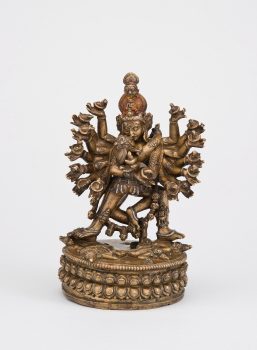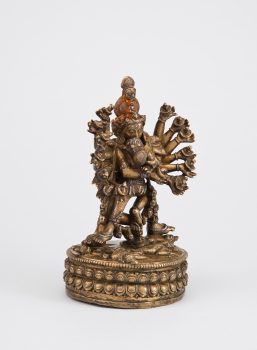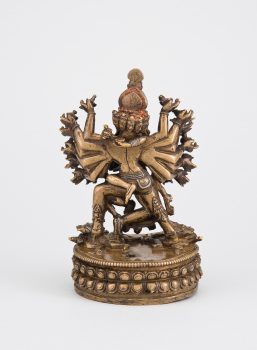Tibet or Nepal
14th or 16th - 17th century
A skull cup is an attribute of tantric deities and is usually paired with a curved knife. It can symbolize a mind filled with the bliss of realizing the true nature of reality.
Tibet or Nepal
14th or 16th - 17th century




Hevajra is a principal meditational deity in a secret tantric practice especially important to the Sakya Buddhist tradition. Here he is shown with eight heads, sixteen arms, and four legs. Each face has three wide eyes and an open, smiling mouth. Hevajra appears in union with his consort, Nairatmya, who is wearing a necklace of skulls. The two are stamping on human bodies as a symbol of taming enemies and cutting through ignorance. The fan-shaped hair knots, row of multiple heads, and facial features, as well as the sculpture’s circular pedestal, are reminiscent of works of art from northeastern India. However, the proportions of the figures and less-refined details suggest it has a Tibetan origin.
A religious movement that originated in India around the fifth to seventh century with sacred writings and esoteric teachings and practices transmitted from teacher to student through initiation. These remain an important part of Hinduism and Buddhism today.
A contemplative practice in which a person uses concentration and visualization to achieve aims such as transforming the mind and generating feelings of compassion. Techniques include focusing on breathing or visualizing oneself as a deity.
A meditation technique primarily used in tantric practice that involves imagining a deity in one’s mind or imagining oneself becoming a deity and carrying out various activities. Such techniques are intended to help a practitioner transform ordinary perception and achieve enlightened qualities.
Tantric deities personify various enlightened qualities and are the focus of esoteric religious practices (tantras) that aim to swiftly and radically transform one’s understanding of reality.
The Himalayan kingdoms of the Kathmandu Valley were significant centers of Buddhist culture. Nepalese kings, Buddhist institutions, and ordinary people patronized the vibrant art guilds. The artistic traditions of the regions are well-known in Tibetan areas and beyond, and Newar artists have always been in high demand throughout Tibetan regions and Inner Asia.
Today, Tibetans primarily inhabit the Tibetan Plateau, situated between the Himalayan mountain range and the Indian subcontinent to the west, Chinese cultural regions to the east, and Mongolian cultural regions to the northeast. During the 7th to 9th century, Tibetan rulers expanded their empire across Central Asia, and established Buddhism as the state religion.
Get the latest news and stories from the Rubin, plus occasional information on how to support our work.